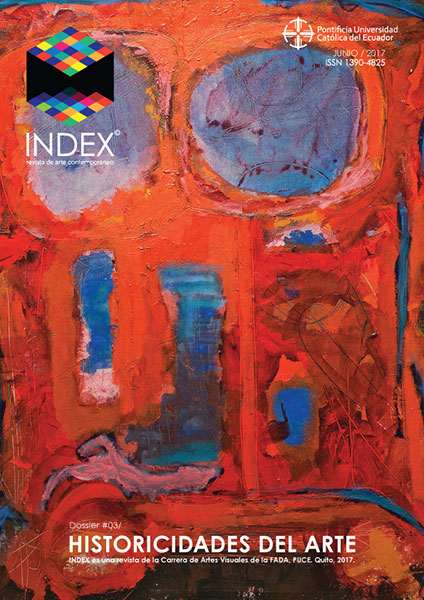Los museos como mediadores de la memoria en la era digital
Contenido principal del artículo
Resumen
En la era de las cámaras digitales, las redes sociales, el big data y la autorepresentación, ¿dónde queda el rol del museo como custodio de la memoria? En ese artículo se indagará en cómo se intersectan y dialogan el museo y los medios digitales, en tanto administradores y medios de la memoria social. Se abordará los retos que enfrenta el museo al incorporar nuevas tecnologías en el espacio expositivo y como herramientas educativas, enfatizando en procesos colectivos de generación de sentidos. Se revisará tendencias en el museo virtual y sus problemáticas en torno a la apertura de colecciones. Finalmente, se abordarán los retos del museo como mediador en procesos de cocuraduría y coproducción de contenidos con comunidades.
Palabras Clave: Museo, tecnologías digitales, museo virtual, cocuraduría, memoria social, contenidos coproducidos, mediación comunitaria.
Descargas
Detalles del artículo
Index, revista de arte contemporáneo maneja sus derechos bajo licencia Creative Commons Reconocimiento-NoComercial 4.0. En ese sentido los envíos quedan sujetos a la decisión del autor.
Citas
Bassett, C. (2008). Narrative machines. En The Arcand the Machine: Narrative and New Media(pp. 5-42). Manchester ; New York : New York: Manchester University Press.
Blanchette, J. F. (2011). The noise in the archive: oblivion in the age of total recall. En Computers, Privacy and Data Protection: an Element of Choice (pp. 25-38). Springer Netherlands. BME. (2014). Smartickets. Recuperado 19 de abril de 2014, a partir de http://www.britishmusicexperience.com/smartickets
Brea, J. L. (2007). Cultura RAM, mutaciones de la cultura en la era de su distribución electronica. Barcelona: Editorial GEDISA.
Bolter, J. D., & Grusin, R. (2000), Remediation: Understanding New Media. New York: The MIT Press.
Cairns, S., & Birchall, D. (2013). Curating the digital world: past preconceptions, present problems, possible futures. Presentado en The annual conference of museums and the web, Portland, USA: Archives and Museum
Informatics.
Cameron, F. (2006). Digital Futures I: museum collections, digital technologies, and the cultural construction of knowledge. School of Philosophical and Historical Inquiry, University of Sydney, 325-340.
Castells, M. (2010). Museum in the informationera: cultural connector of time and space. ICOM, 227-436.
Charitonos, K., Blake, C., Scanlon, E., & Jones,
A. (2012). Museums learning via social and mobile technologies: (how) can online interactions enhance the visitor experience? British Journal of Educational Technology,43(5), 802-819.
Deuze, M. (2003). The web and its journalisms: considering the consequences of different types of newsmedia online. New Media and Society, 5(2), 203-230.
dos Santos, P. (2010). To understand new museology in the 21st century. Sociomuseology, 3(45), 5-13.
Eschenfelder, K. R., & Caswell, M. (2010). Digital cultural collection in an age of reuse and remixes. Proceedings of the American Society for Information Science and Technology 47(1).
Frost, O. C. (2010). When the object is digital: properties of digital surrogate objects and implications for learning. En Museums in aDigital Age, ed. Ross Parry. London ; New
York: Routledge.
Geismar, H. (2011). Social relationships and digital relationships: rethinking the database at the Vanuatu Cultural Center. Journal of the Royal Anthropological Institute, 133-155.
Heath, C., & Van Lehn, D. (2010). Interactivity and collaboration: new forms of participation in museums, galleries and science centers. En Museums in a Digital 30 Age, ed. Ross Parry. London ; New York: Routledge.
Hein, H. S. (2000). The Museum in Transition: A Philosophical Perspective. Washington: Smithsonian Books.
Macek, J. (2013). More than a desire for text: online participation and the social curation of content. Convergence, 19, 295-302.
Marty, P. F. (1999). Museum informatics and collaborative technologies: the emerging socio-technological dimension of information science in museum environment. Journal of the American Society for Information Science, 50(12), 1083-1091.
Message, K. (2006). New Museums and the Making of Culture. Oxford, UK ; N.Y., NY: Bloomsbury Academic.
Müller, K. (2002). Museums and virtuality. Curator, 45(1), 22-33.
Parry, R. (2007). Recoding the museum: digital heritage and the technologies of change. London; New York: Routledge.
Postigo, H. (2012). Cultural Production and the Digital Rights Movement. Information, Communication and Society, 15(8), 1165-1185.
QRator Project. (2011). QRator Project. Recuperado el 4 de enero de 2017, a partir de http://www.qrator.org/about-the-project/what-is-qrator/
Ross, M. (2004). Interpreting the new museology. Museums and Society, 2(2), 84-103.
Sabharwal, A. (2012). Networked co-curation in virtual museums: digital humanities, history, and social media in the Toledo"™s Attic Project. International Journal of Heritage in the Digital Era, 1(4), 588-608.
Schwartz, J. M., & Cook, T. (2002). Archives, records, and power: the making of modern memory. Archival Science, 2, 1-19.
Somerville, M. M., & EchoHawk, D. (2011). Knowledge with community significance. Library Trends, 59(4), 650-662.
Srinivasan, R., Boast, R., Furner, J., & Becvar, K. M. (2009). Digital museums and diverse cultural knowledges: moving past the traditional catalog. The Information Society, 25, 265-278.
Sturken, M. (2008). Memory, consumerism and media: reflections on the emergence of the field. Memory Studies, 1(1), 73-78.
TAP. (2014). Toledo"™s Attic Project. Recuperado 4 de enero de 2017, a partir de http://www.toledosattic.org/
Tarkovsky, A. (1972). Solaris.
Trant, J. (2010). When all you got is «the real thing»: museums and authenticity in the network world. En Museums in a Digital Age, ed. Ross Parry. London ; New York: Routledge.
Van House, N., & Churchill, E. F. (2008). Technologies of memory: key issues and critical perspectives. Memory Studies, 1, 295-308.
Villi, M., Moisander, J., & Joy, A. (2012). Social curation in consumer communities: consumers as curators of online media content. Advances in Consumer Research, 40, 490.
Wolff, A., & Mulholland, P. (2013). Curation, curation, curation. Knowledge Media Institute - The Open University, 1-9

